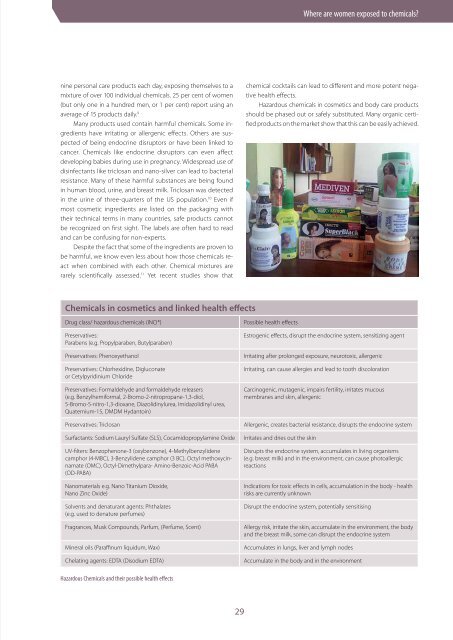Women and Chemicals
1ToENNR
1ToENNR
Create successful ePaper yourself
Turn your PDF publications into a flip-book with our unique Google optimized e-Paper software.
Where are women exposed to chemicals?<br />
nine personal care products each day, exposing themselves to a<br />
mixture of over 100 individual chemicals. 25 per cent of women<br />
(but only one in a hundred men, or 1 per cent) report using an<br />
average of 15 products daily. 9<br />
Many products used contain harmful chemicals. Some ingredients<br />
have irritating or allergenic effects. Others are suspected<br />
of being endocrine disruptors or have been linked to<br />
cancer. <strong>Chemicals</strong> like endocrine disruptors can even affect<br />
developing babies during use in pregnancy. Widespread use of<br />
disinfectants like triclosan <strong>and</strong> nano-silver can lead to bacterial<br />
resistance. Many of these harmful substances are being found<br />
in human blood, urine, <strong>and</strong> breast milk. Triclosan was detected<br />
in the urine of three-quarters of the US population. 10 Even if<br />
most cosmetic ingredients are listed on the packaging with<br />
their technical terms in many countries, safe products cannot<br />
be recognized on first sight. The labels are often hard to read<br />
<strong>and</strong> can be confusing for non-experts.<br />
Despite the fact that some of the ingredients are proven to<br />
be harmful, we know even less about how those chemicals react<br />
when combined with each other. Chemical mixtures are<br />
rarely scientifically assessed. 11 Yet recent studies show that<br />
chemical cocktails can lead to different <strong>and</strong> more potent negative<br />
health effects.<br />
Hazardous chemicals in cosmetics <strong>and</strong> body care products<br />
should be phased out or safely substituted. Many organic certified<br />
products on the market show that this can be easily achieved.<br />
<strong>Chemicals</strong> in cosmetics <strong>and</strong> linked health effects<br />
Drug class/ hazardous chemicals (INCI*)<br />
Preservatives:<br />
Parabens (e.g. Propylparaben, Butylparaben)<br />
Preservatives: Phenoxyethanol<br />
Preservatives: Chlorhexidine, Digluconate<br />
or Cetylpyridinium Chloride<br />
Preservatives: Formaldehyde <strong>and</strong> formaldehyde releasers<br />
(e.g. Benzylhemiformal, 2-Bromo-2-nitropropane-1,3-diol,<br />
5-Bromo-5-nitro-1,3-dioxane, Diazolidinylurea, Imidazolidinyl urea,<br />
Quaternium-15, DMDM Hydantoin)<br />
Preservatives: Triclosan<br />
Surfactants: Sodium Lauryl Sulfate (SLS), Cocamidopropylamine Oxide<br />
UV-filters: Benzophenone-3 (oxybenzone), 4-Methylbenzylidene<br />
camphor (4-MBC), 3-Benzylidene camphor (3 BC), Octyl methoxycinnamate<br />
(OMC), Octyl-Dimethylpara- Amino-Benzoic-Acid PABA<br />
(OD-PABA)<br />
Nanomaterials e.g. Nano Titanium Dioxide,<br />
Nano Zinc Oxide)<br />
Solvents <strong>and</strong> denaturant agents: Phthalates<br />
(e.g. used to denature perfumes)<br />
Fragrances, Musk Compounds, Parfum, (Perfume, Scent)<br />
Mineral oils (Paraffinum liquidum, Wax)<br />
Chelating agents: EDTA (Disodium EDTA)<br />
Possible health effects<br />
Estrogenic effects, disrupt the endocrine system, sensitizing agent<br />
Irritating after prolonged exposure, neurotoxic, allergenic<br />
Irritating, can cause allergies <strong>and</strong> lead to tooth discoloration<br />
Carcinogenic, mutagenic, impairs fertility, irritates mucous<br />
membranes <strong>and</strong> skin, allergenic<br />
Allergenic, creates bacterial resistance, disrupts the endocrine system<br />
Irritates <strong>and</strong> dries out the skin<br />
Disrupts the endocrine system, accumulates in living organisms<br />
(e.g. breast milk) <strong>and</strong> in the environment, can cause photoallergic<br />
reactions<br />
Indications for toxic effects in cells, accumulation in the body - health<br />
risks are currently unknown<br />
Disrupt the endocrine system, potentially sensitising<br />
Allergy risk, irritate the skin, accumulate in the environment, the body<br />
<strong>and</strong> the breast milk, some can disrupt the endocrine system<br />
Accumulates in lungs, liver <strong>and</strong> lymph nodes<br />
Accumulate in the body <strong>and</strong> in the environment<br />
Hazardous <strong>Chemicals</strong> <strong>and</strong> their possible health effects<br />
29


